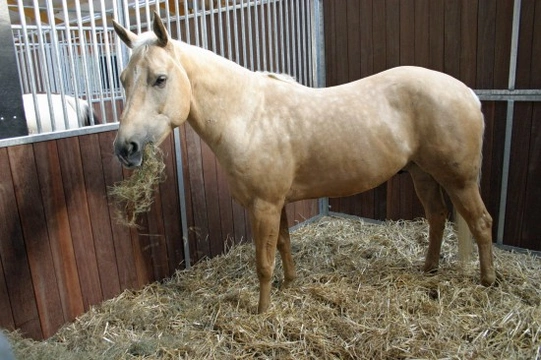
How Good is the Hay You Feed Your Horse?
Over the winter months horses are fed larger volumes of hay mainly because many are kept stabled for longer periods of time. This is typically due to the bad weather owners have to deal with until the spring arrives. This is when horses are more prone to develop a few nasty respiratory disorders which is why it's so important to makes sure you only feed top quality hay over the wintertime.
The best way to check the quality of hay is to do so in the old fashioned way which is to break open a bale. This allows you to see how dusty it might be and it lets you see if the hay has a nice and fresh smell to it. However, you don't want to feed a horse hay that's too green or you might find they end up scouring and developing all sorts of other digestive disorders!
Top quality hay will have a nice greenish colour to it rather than a dirty yellow or brown tinge to it. You also need to bear in mind that if the hay has a high clover content that it will darken a lot more as it ages. You need to check whether or not there is a lot of leaf content in the hay because this means it's a better quality having been cut earlier than hay that has a lot of stems and weeds in it which is typically cut that much later.
Good Quality Hay is Sweet Smelling
Good quality hay has a nice sweet smell to it that's pleasant and not at all musky. If you notice any mould whether it's dark or light in colour this is not a good sign and it should not be fed to horses.
You should also take a handful of hay and squeeze it. If it's prickly, this means it's a later cut and therefore has a pretty low nutrient content. Dust is always a big issue with hay and some owners have to dampen it down before feeding it to their horses.
However, if the hay has been cut with the tines of the harvester set too low, this too can make hay dusty even if the grass was cut at a good time and the hay is sweet smelling. You should always avoid buying dusty hay as it will just make a respiratory problem even worse.
Hay may look great, but appearance alone is not a true indication of its nutritional value. However, the only real way of finding this out is to have an analysis carried out which naturally is not a viable option for most horse owners.
How Much Hay Should You Feed?
As a rule of thumb and under normal circumstances when it comes to forages, horses need to be fed anything from 1% to 2% of body weight every day unless they are in intensive training that is. The only real way to ensure a horse is being fed adequate amounts of hay is to weigh it, but again this is not always an option with most owners just filling haynets or hay racks for their horses as and when needed.
Horses need to graze and they are designed to chew on fibrous plants for a minimum of 12 hours each and every day which is why they need to be fed sufficient amounts of good quality hay when stabled for any length of time. Providing enough hay satisfies not only a horse's need for nutrients to keep their digestive tracts nice and healthy, but also their strong desire to chew. This means there's far less chance of boredom setting in which could lead to them developing all sorts of vices, including crib biting!
A Constant Supply of Hay is Preferable
It is far better for horses to have constant access to hay when they are standing in rather than to be fed a couple of large amounts during the day. The reason being they can nibble at it throughout the time they are stabled which imitates their natural need to graze.
Hay Needs to be Stored Correctly
Feeding good quality hay provides enough nutritional value which should keep your hard feed bill down. This is a real bonus that should not be ignored. However, the way you store your hay is also essential because if it is not kept in a clean and dry environment, it will very quickly deteriorate and therefore not provide your horse with enough nutrients.
Conclusion
Buying in good quality hay is essential because if your horse needs to be kept stabled for longer periods of time over the winter months, they will need the nutrients it provides them with and keep their digestive tracts nice and healthy. As a bonus, feeding top quality hay should mean a lower hard feed bill which horse owners always welcome. However, if you don't have a good area to store hay, it's far better to buy it in smaller amounts than to keep a lot in a place where it will quickly deteriorate and get mouldy.



